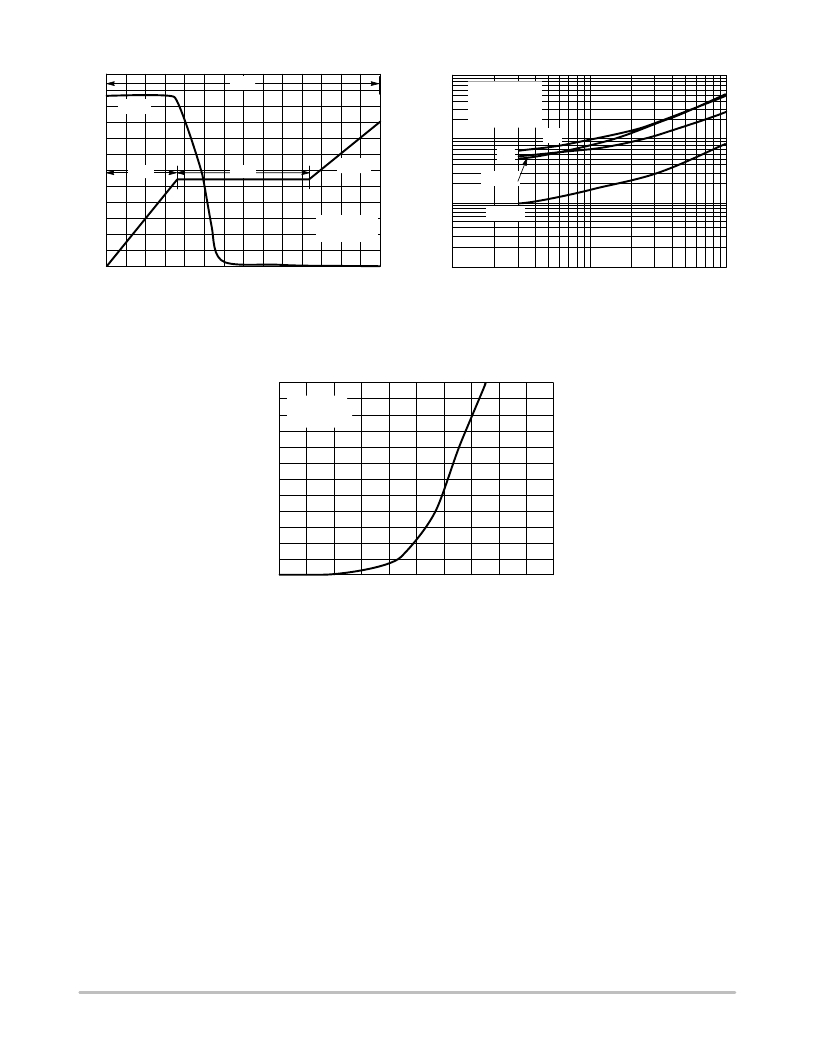- 您现在的位置:买卖IC网 > Sheet目录486 > NTB30N20T4G (ON Semiconductor)MOSFET N-CH 200V 30A D2PAK
�� �
�
NTB30N20�
�12�
�10�
�8�
�V� DS�
�Q� T�
�180�
�150�
�120�
�1000�
�100�
�V� DD� =� 160� V�
�I� D� =� 30� A�
�V� GS� =� 10� V�
�t� f�
�6�
�4�
�2�
�Q� 1�
�Q� 2�
�V� GS�
�I� D� =� 30� A�
�T� J� =� 25� °� C�
�90�
�60�
�30�
�10�
�t� r�
�t� d(off)�
�t� d(on)�
�0�
�0�
�10�
�20�
�30�
�40�
�50�
�60�
�0�
�70�
�1�
�1�
�10�
�100�
�Q� G� ,� TOTAL� GATE� CHARGE� (nC)�
�Figure� 8.� Gate?To?Source� and� Drain?To?Source�
�Voltage� versus� Total� Charge�
�R� G� ,� GATE� RESISTANCE� (� W� )�
�Figure� 9.� Resistive� Switching� Time�
�Variation� versus� Gate� Resistance�
�DRAIN?TO?SOURCE� DIODE� CHARACTERISTICS�
�30�
�25�
�20�
�15�
�10�
�5�
�0�
�V� GS� =� 0� V�
�T� J� =� 25� °� C�
�0.5�
�0.6� 0.7� 0.8� 0.9�
�1�
�V� SD� ,� SOURCE?TO?DRAIN� VOLTAGE� (VOLTS)�
�Figure� 10.� Diode� Forward� Voltage� versus� Current�
�SAFE� OPERATING� AREA�
�The� Forward� Biased� Safe� Operating� Area� curves� define�
�the� maximum� simultaneous� drain?to?source� voltage� and�
�drain� current� that� a� transistor� can� handle� safely� when� it� is�
�forward� biased.� Curves� are� based� upon� maximum� peak�
�junction� temperature� and� a� case� temperature� (T� C� )� of� 25� °� C.�
�Peak� repetitive� pulsed� power� limits� are� determined� by� using�
�the� thermal� response� data� in� conjunction� with� the� procedures�
�discussed� in� AN569,� “Transient� Thermal�
�Resistance?General� Data� and� Its� Use.”�
�Switching� between� the� off?state� and� the� on?state� may�
�traverse� any� load� line� provided� neither� rated� peak� current�
�(I� DM� )� nor� rated� voltage� (V� DSS� )� is� exceeded� and� the�
�transition� time� (t� r� ,t� f� )� do� not� exceed� 10� m� s.� In� addition� the� total�
�power� averaged� over� a� complete� switching� cycle� must� not�
�exceed� (T� J(MAX)� ?� T� C� )/(R� q� JC� ).�
�A� Power� MOSFET� designated� E?FET� can� be� safely� used�
�reliable� operation,� the� stored� energy� from� circuit� inductance�
�dissipated� in� the� transistor� while� in� avalanche� must� be� less�
�than� the� rated� limit� and� adjusted� for� operating� conditions�
�differing� from� those� specified.� Although� industry� practice� is�
�to� rate� in� terms� of� energy,� avalanche� energy� capability� is� not�
�a� constant.� The� energy� rating� decreases� non?linearly� with� an�
�increase� of� peak� current� in� avalanche� and� peak� junction�
�temperature.�
�Although� many� E?FETs� can� withstand� the� stress� of�
�drain?to?source� avalanche� at� currents� up� to� rated� pulsed�
�current� (I� DM� ),� the� energy� rating� is� specified� at� rated�
�continuous� current� (I� D� ),� in� accordance� with� industry� custom.�
�The� energy� rating� must� be� derated� for� temperature� as� shown�
�in� the� accompanying� graph� (Figure� 12).� Maximum� energy� at�
�currents� below� rated� continuous� I� D� can� safely� be� assumed� to�
�equal� the� values� indicated.�
�in� switching� circuits� with� unclamped� inductive� loads.� For�
�http://onsemi.com�
�5�
�发布紧急采购,3分钟左右您将得到回复。
相关PDF资料
NTB35N15T4
MOSFET N-CH 150V 37A D2PAK
NTB52N10T4G
MOSFET N-CH 100V 52A D2PAK
NTB5405NG
MOSFET N-CH 40V 116A D2PAK
NTB5411NT4G
MOSFET N-CH 60V 80A D2PAK
NTB5412NT4G
MOSFET N-CH 60V 60A D2PAK
NTB5426NT4G
MOSFET N-CH 60V 120A D2PAK
NTB5605T4G
MOSFET P-CH 60V 18.5A D2PAK
NTB6410ANG
MOSFET N-CH 100V 76A D2PAK
相关代理商/技术参数
NTB-3402
制造商:Quest Technology International Inc 功能描述:
NTB35N15
功能描述:MOSFET 150V 37A N-Channel RoHS:否 制造商:STMicroelectronics 晶体管极性:N-Channel 汲极/源极击穿电压:650 V 闸/源击穿电压:25 V 漏极连续电流:130 A 电阻汲极/源极 RDS(导通):0.014 Ohms 配置:Single 最大工作温度: 安装风格:Through Hole 封装 / 箱体:Max247 封装:Tube
NTB35N15G
功能描述:MOSFET 150V 37A N-Channel RoHS:否 制造商:STMicroelectronics 晶体管极性:N-Channel 汲极/源极击穿电压:650 V 闸/源击穿电压:25 V 漏极连续电流:130 A 电阻汲极/源极 RDS(导通):0.014 Ohms 配置:Single 最大工作温度: 安装风格:Through Hole 封装 / 箱体:Max247 封装:Tube
NTB35N15T4
功能描述:MOSFET 150V 37A N-Channel RoHS:否 制造商:STMicroelectronics 晶体管极性:N-Channel 汲极/源极击穿电压:650 V 闸/源击穿电压:25 V 漏极连续电流:130 A 电阻汲极/源极 RDS(导通):0.014 Ohms 配置:Single 最大工作温度: 安装风格:Through Hole 封装 / 箱体:Max247 封装:Tube
NTB35N15T4G
功能描述:MOSFET 150V 37A N-Channel RoHS:否 制造商:STMicroelectronics 晶体管极性:N-Channel 汲极/源极击穿电压:650 V 闸/源击穿电压:25 V 漏极连续电流:130 A 电阻汲极/源极 RDS(导通):0.014 Ohms 配置:Single 最大工作温度: 安装风格:Through Hole 封装 / 箱体:Max247 封装:Tube
NTB-3602
制造商:Quest Technology International Inc 功能描述:
NTB40603AS
制造商:IKO NIPPON THOMPSON 功能描述:AXL NDL RLR 40MM
NTB4302
功能描述:MOSFET 30V 74A N-Channel RoHS:否 制造商:STMicroelectronics 晶体管极性:N-Channel 汲极/源极击穿电压:650 V 闸/源击穿电压:25 V 漏极连续电流:130 A 电阻汲极/源极 RDS(导通):0.014 Ohms 配置:Single 最大工作温度: 安装风格:Through Hole 封装 / 箱体:Max247 封装:Tube